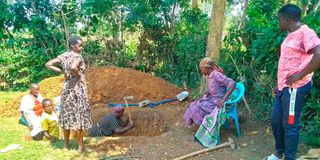Gendered to the grave: How burial customs reflect and reinforce societal gender norms

A group of women from Tukundereza Revival dig the grave of the late Helida Ogweno at her home in Ugenya ,Siaya County on July 3, 2024. The women went against Luo traditions that demand that only men should dig a grave.
What you need to know:
- African funeral rites often reflect and reinforce traditional gender roles, from mourning styles to burial orientations.
- These practices can have lasting impacts on the lives of widows, sometimes limiting their rights and freedoms.
“Women defy culture, dig grave for friend” was the title of a story by Angeline Ochieng’ (Sunday Nation July, 7 2024). Christian women in Ng’ole Village in Ugenya, Siaya County, dug a grave for their deceased team mate Helida Ogweno, carried her coffin and lowered it into the grave, contrary to Luo traditions that prescribe such roles for men. The story aligns with the dictum in orthodox journalism that it is not news when dog bites man but it is when the opposite happens.
This episode brings to mind various gendered funerary rites. When a married Luo man dies, it is the responsibility of his wife to tero yuak (make the announcement, literally travel to break the news). This means that learning the art of mourning is part of her job description. The practice is similar among the Abagusii where the wife initiates the mourning by ululating.
Men’s and women’s styles of mourning also differ. In a 2018 paper “Gender and the changing funeral and burial practices among the Gusii people of Kenya”, in the International Journal of Recent Research in Interdisciplinary SciencesVol. 5, Issue 4, Mildred Nyaboke Ayuka, records that women among the Abagusii weep while men who do so are considered effeminate.
In the Luo community, while women wail and sing, flailing their arms and wallowing on the ground, men do mock dances with death while performing incantatory dirges using spears, clubs and shields in what is referred to as goyo sira.
It is also men’s traditional roles among the Luo to dig the grave, carry and lower the coffin and cover the grave. They also slaughter the animals for feeding mourners. The traditional system also dictates that the first animal slaughtered in a woman’s funeral must be a cow and for men, a bull.
One of the gendered mourning rites among the Luo is tero buru. Young men bedecked with twigs and tendrils move with a huge herd of cattle from the village beating drums to escort the spirit of the dead man to the wilderness. They return in the late afternoon to be received by the eldest son in a mock dance, a succession ritual in which he now assumes the leadership of the homestead. Tero buru is an exclusive male activity - done by and for men.
A common traditional practice in many African communities is that a widow has to wear a mourning gown pending de-mourning rites to enable her resume normal life. In the olden days, a Luo widow would wear the husband’s overcoat called jamba as a physical reminder of his departure and visible symbol of her status.
Among the Gusii, a widow would “walk with one arm across the chest” for several months, and avoid physical contact when greeting. In the Kingdom of Eswatini, a widow wears a black gown covering her body and face for six months to two years during which her mobility and activities are restricted.
A report by Widows for Democracy in Eswatini notes that widows have been denied opportunity to register as voters because of the stigma. This limits enjoyment of their rights. The report also observes that forcing widows to re-marry prescribed partners limits their freedom of choice and often exposes them to deleterious lifestyles. The stigma on widows is captured in the Luo reference to them as mond liete (wives of graves). There is no corresponding reference for widowers.
Gender roles
Funerary rites are pervaded by patriarchal rightist ideology. In the Luo community, a man’s grave occupies the right hand side relative to the wife’s hut with the head facing the inside of the homestead. For a woman, it is the opposite, to signify that she was a foreigner and denoting the man’s superiority. Among the Gusii, ‘rightism” is evident in the practice that the man’s corpse lies reclined on his right side while that of the woman does so on the left. Right as the masculine arm and left as the feminine one is also found among the Luhyia.
An unmarried daughter is traditionally buried outside the homestead among the Luo and near the fence among the Luhyia, to indicate that she should have ideally married and exited the home.
In Mali, the artefacts people are buried with reflect their gender. And in Ethiopia, stelae also designate the gender of the deceased. These means that social construction outlasts life much as it is also perceived before birth.
The step by the Siaya women illustrates that gender roles are socially constructed not biologically determined, and can be performed by anyone without any ominous consequences. It demonstrates that change is brought about by people daring enough to challenge and dismantle existing patriarchal boundaries.
The writer is a lecturer in Gender and Development Studies at South Eastern Kenya University ([email protected])





